The desert presents challenging environmental conditions for many plants, yet some trees survive, thrive, and flourish. These resilient trees have adapted to extreme temperatures, prolonged drought, and nutrient-poor soils. Yet they provide much-needed shade, beauty, and a unique character to arid landscapes.
In this exploration of the captivating world of desert trees, we will dive into various species, their remarkable adaptations, and the vital roles they play in both natural ecosystems and cultivated desert settings. From their unique root systems that tap into deep water sources to their ability to minimize water loss, these trees exemplify the wonders of nature’s resilience.
Common Types of Trees that Grow in the Desert
The Desert Willow Tree (Chilopsis linearis)
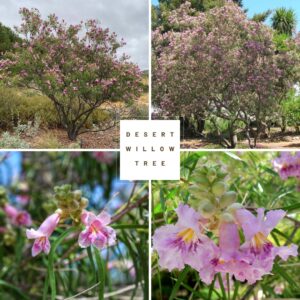
The Desert Willow is a stunning and resilient tree that bears a resemblance to true willows, thanks to its narrow, elongated leaves. However, it belongs to a different plant family. It is native to the southwestern U.S. and Mexico. This tree thrives in arid climates where water is scarce. One of the most striking features of the Desert Willow is its beautiful trumpet-shaped flowers, which bloom in shades ranging from lavender to pink. These blossoms attract pollinators like bees and hummingbirds, adding vibrant appeal to the landscape. Despite its name, the desert willow is not a true willow and requires much less water, making it a popular choice for water-conscious landscaping. With its ability to flourish in dry conditions while providing beauty and habitat for wildlife, the Desert Willow stands out as a remarkable tree in harsh conditions.
- USDA Growing Zone: 7 to 11
- Sun Exposure: Full Sun
- Soil Needs: Tolerant of almost all well-drained soils
Blue Palo Verde (Parkinsonia florida)
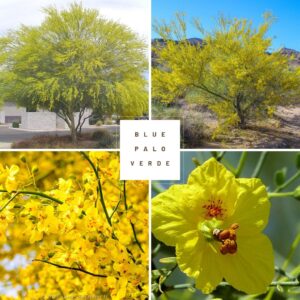
Palo Verde (Parkinsonia Florida) is renowned for its distinctive green bark. It is a tree or large shrub that can grow up to 30 feet tall and 20 feet wide. Furthermore, Paolo Verde can photosynthesize even when its small leaves fall off during periods of extreme heat. This unique adaptation enables the tree to continue producing energy while conserving water. Which makes it exceptionally well-suited for harsh desert environments. These trees are a common sight in desert landscapes, where they thrive despite long stretches of drought. Their resilience allows them to endure the rigors of arid conditions, contributing to the ecological diversity of these regions. These trees provide shade and shelter for various wildlife, including birds and insects. The vibrant yellow flowers attract the pollinators which enhances the overall biodiversity of the area.
- USDA Growing Zone: 8 to 11
- Sun Exposure: Full Sun
- Soil Needs: Well-drained neutral or alkaline soils
Arizona or Velvet Mesquite (Prosopis velutina)
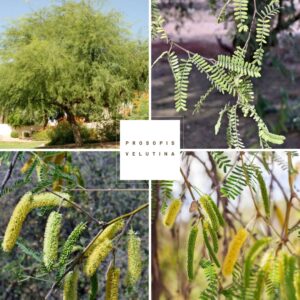
Arizona or Velvet Mesquite (Prosopis velutina) exhibit remarkable drought tolerance, thanks to their deep root systems. These deep root systems allow them to tap into water sources that are located far beneath the desert surface. This tree can grow to 50 feet tall and 50 feet wide. This ability to reach deep groundwater is crucial for their survival in harsh and arid conditions where surface water is scarce. In addition to their impressive water conservation capabilities, these trees provide much-needed shade with their expansive canopies. These canopies create a cooler microenvironment for both plants and animals in the harsh desert heat. These trees produce pods that serve as a vital food source for various wildlife species. These nutritious pods attract birds, mammals, and insects, contributing to the overall biodiversity of the desert ecosystem. Furthermore, its yellow flowers provide ample nectar for honey bees.
- USDA Growing Zone: 9 to 11
- Sun Exposure: Full Sun
- Soil Needs: Tolerates a wide variety of soils
Desert Ironwood (Olneya tesota)
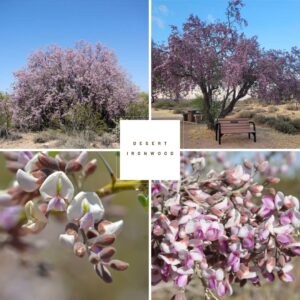
Ironwood is a slow-growing, long-lived tree renowned for its incredibly dense hardwood, which makes it one of the most durable species in desert environments. Desert ironwood can be grown as a tree or tall shrub; it grows up to 30 feet tall. This remarkable tree endures harsh conditions and provides crucial shade and shelter for various wildlife. The shade provided by ironwood trees creates a cooler microclimate beneath their broad canopies, benefiting smaller plants and seedlings that may struggle in the intense desert sun. Additionally, the tree serves as a sanctuary for wildlife, providing nesting sites and protection from predators. Desert ironwood is not suitable for coastal environments, as it does not tolerate humidity.
- USDA Growing Zone: 9 to 10
- Sun Exposure: Full Sun
- Soil Needs: Rocky, well-drained soils
Joshua Tree (Yucca brevifolia)
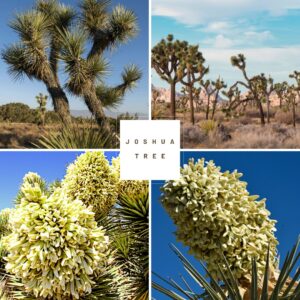
Joshua trees, iconic symbols of the Mojave Desert, are fascinating plants that belong to the yucca family. These unique trees derive their name from their distinctive, spiky, tree-like appearance, which resembles the outstretched arms of a Joshua tree, evoking images of biblical stories and landscapes. Characterized by their tall (they can grow up to 30 feet tall), branching structure and striking rosettes of spiky leaves, Joshua trees thrive in the harsh conditions of the desert, where they can endure extreme temperatures and low rainfall. Additionally, their unique growth form not only distinguishes them visually but also plays a vital role in the desert ecosystem, providing habitat and shelter for various wildlife species, including birds, insects, and small mammals. Birds use them as nesting sites and their seeds are food for many forms of desert wildlife.
- USDA Growing Zone: 6 to 10
- Sun Exposure: Full Sun
- Soil Needs: Tolerates infertile, well-drained soils
The Arch Rock Desert Loop offers a picturesque hiking experience in Joshua Tree National Park, celebrated for its striking natural rock formations and, of course, the iconic Joshua Tree. This park is a unique convergence zone where the Mojave and Colorado deserts meet, resulting in a breathtaking variety of desert plant species, including the Joshua Tree itself. These trees are vital to the ecosystem, offering habitat and nourishment for the yucca moth, a key pollinator. The area draws visitors for hiking and photography, showcasing the desert’s rugged beauty and unique trees. Whether you’re exploring the trails or capturing the scenery, the Arch Rock Desert Loop offers an unforgettable glimpse into the natural wonders of Joshua Tree National Park.
Are There Trees in the Desert?
Absolutely, trees can thrive in desert environments, but they must have specific adaptations to endure the extreme conditions. Furthermore, desert trees such as mesquite, palo verde, and desert willow have evolved remarkable features that enable them to survive where many other plants cannot.
These adaptations include deep root systems that reach far below the surface to access moisture that is unavailable to most vegetation. Although many desert trees have small or even no leaves, reducing water loss through evaporation. Some species can even enter a dormant state during periods of severe drought, allowing them to conserve energy and resources until conditions improve.
Such adaptations are crucial for survival in some of the driest climates on Earth, where rainfall is scarce and temperatures can soar. These resilient trees manage water use and harsh conditions, providing shade and habitat for wildlife. Their presence enhances the biodiversity of arid landscapes, showcasing nature’s incredible ability to adapt to challenging environments.
Thank you for reading, for more interesting articles please visit our homepage.

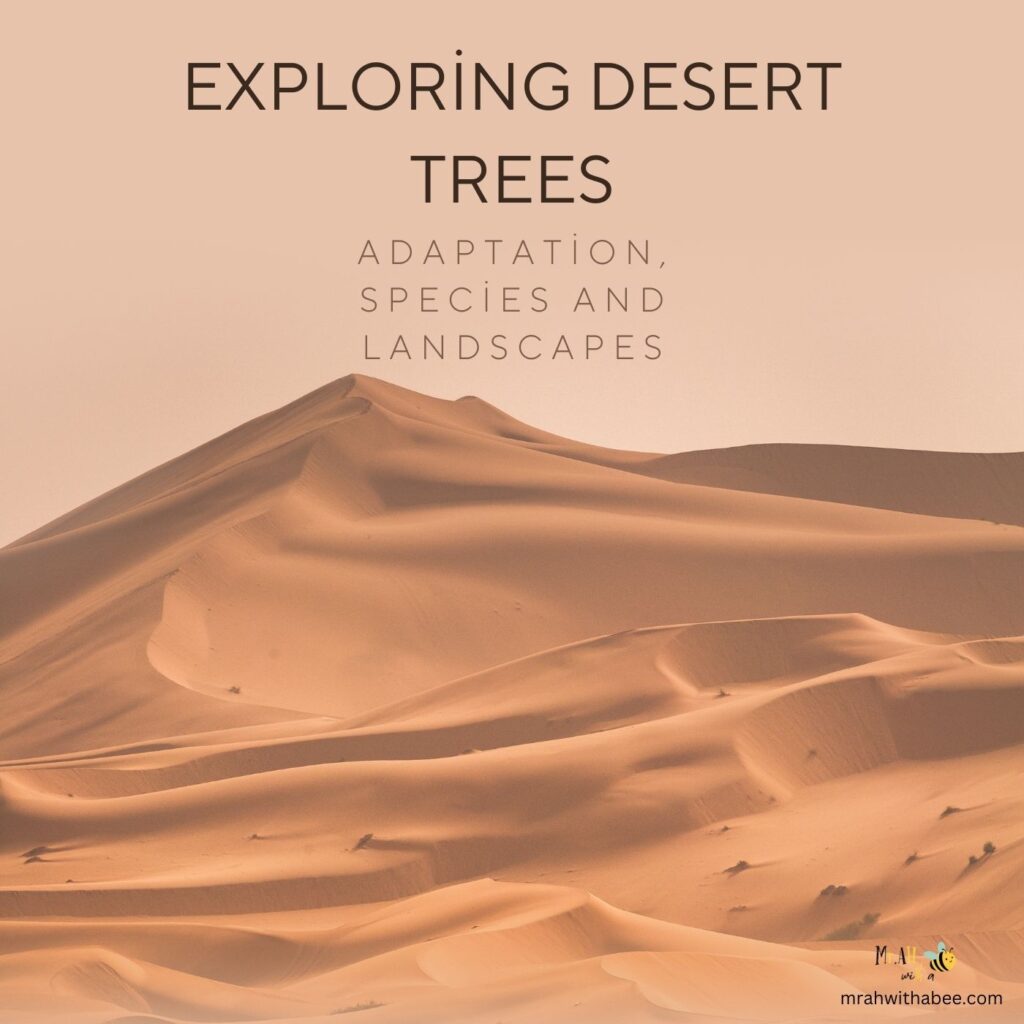


Pingback: Mexican Heather Plant Care: A Complete Guide